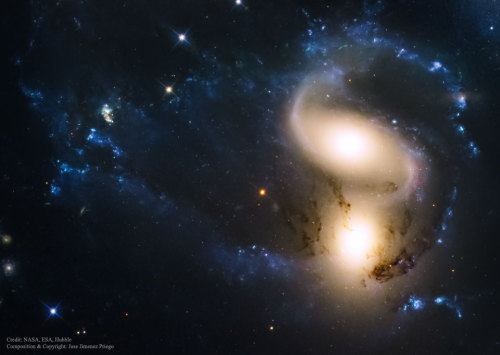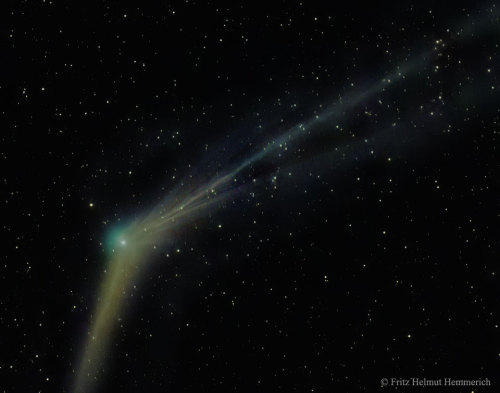Crab Pulsar At The Core Of The Crab Nebula

Crab Pulsar at the core of the Crab Nebula
More Posts from Littlecadet-biguniverse and Others


M8 - Lagoon Nebula Up Close
June is “Lagoon Month” from my latitude. The June and July New Moons will be dedicated to photographing this photogenic nebula. I have booked a camping trip in early June, so I should be able to start capturing some more photons then! :) Here’s my version with limited exposure time from 2013.

Panorama from the Apollo 15 mission

Colliding Galaxies NGC 7318, part of Stephan’s Quintet


Comet Catalina Emerges : Comet Catalina is ready for its close-up. The giant snowball from the outer Solar System, known formally as C/2013 US10 tails, making it an impressive object for binoculars and long-exposure cameras. The featured image was taken last week from the Canary Islands, off the northwest coast of Africa. Sky enthusiasts around the world will surely be tracking the comet over the next few months to see how it evolves. via NASA
js

M94, Cat’s Eye Galaxy

The Spider and the Fly - IC 417
NASA’s Spitzer Space Telescope floats ~93 million miles from earth as it silently observes our universe. In this image we see the nebula IC 417, located in the constellation Auriga, about 10,000 light-years away. Star formation is occurring rapidly in this nebula.
“A cluster of young stars called “Stock 8” can be seen at the top. The light from this cluster carves out a bowl in the nearby dust clouds, seen here as green fluff. Along the sinuous tail in the center and to the bottom, groupings of red point sources are also young stars.”
Credit: NASA/JPL

Amazing photo of the south pole of Mars.

Hubble views a spectacular supernova with interstellar material over 160,000 light-years away by NASA Goddard Photo and Video on Flickr.
This NASA/ESA Hubble Space Telescope image captures the remnants of a long-dead star. These rippling wisps of ionized gas, named DEM L316A, are located some 160,000 light-years away within one of the Milky Way’s closest galactic neighbors — the Large Magellanic Cloud (LMC). The explosion that formed DEM L316A was an example of an especially energetic and bright variety of supernova, known as a Type Ia. Such supernova events are thought to occur when a white dwarf star steals more material than it can handle from a nearby companion, and becomes unbalanced. The result is a spectacular release of energy in the form of a bright, violent explosion, which ejects the star’s outer layers into the surrounding space at immense speeds. As this expelled gas travels through the interstellar material, it heats up and ionizes it, producing the faint glow that Hubble’s Wide Field Camera 3 has captured here. The LMC orbits the Milky Way as a satellite galaxy and is the fourth largest in our group of galaxies, the Local Group. DEM L316A is not the only supernova remnant in the LMC; Hubble came across another one in 2010 with SNR 0509, and in 2013 it snapped SNR 0519. Image credit: ESA (European Space Agency)/Hubble & NASA, Y. Chu

Orion Nebula And Horsehead Nebula
-
 ulvesanger-skjaldmaer reblogged this · 2 years ago
ulvesanger-skjaldmaer reblogged this · 2 years ago -
 nuvivalent42 liked this · 2 years ago
nuvivalent42 liked this · 2 years ago -
 daaaaaaaaaniel liked this · 3 years ago
daaaaaaaaaniel liked this · 3 years ago -
 joharuz liked this · 3 years ago
joharuz liked this · 3 years ago -
 blancopez reblogged this · 3 years ago
blancopez reblogged this · 3 years ago -
 schandefreude reblogged this · 3 years ago
schandefreude reblogged this · 3 years ago -
 acept-arte reblogged this · 3 years ago
acept-arte reblogged this · 3 years ago -
 acept-arte liked this · 3 years ago
acept-arte liked this · 3 years ago -
 byrafayozef liked this · 3 years ago
byrafayozef liked this · 3 years ago -
 astronauths liked this · 3 years ago
astronauths liked this · 3 years ago -
 thefuture431 liked this · 4 years ago
thefuture431 liked this · 4 years ago -
 nib333 liked this · 4 years ago
nib333 liked this · 4 years ago -
 zenpunk-94 liked this · 4 years ago
zenpunk-94 liked this · 4 years ago -
 automaticdestinytrash reblogged this · 5 years ago
automaticdestinytrash reblogged this · 5 years ago -
 fancytail25d liked this · 5 years ago
fancytail25d liked this · 5 years ago -
 mega-aguilarjj-fan-blog liked this · 5 years ago
mega-aguilarjj-fan-blog liked this · 5 years ago
GREETINGS FROM EARTH! Welcome to my space blog! Let's explore the stars together!!!
144 posts